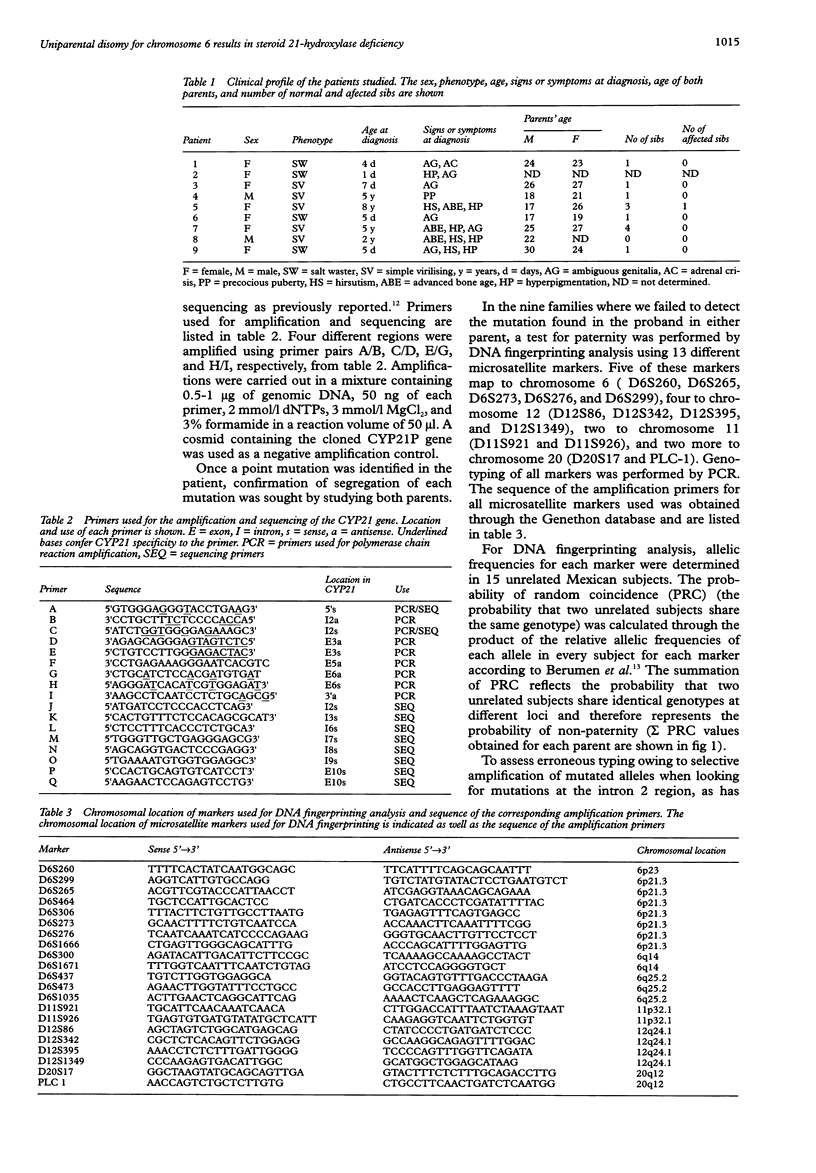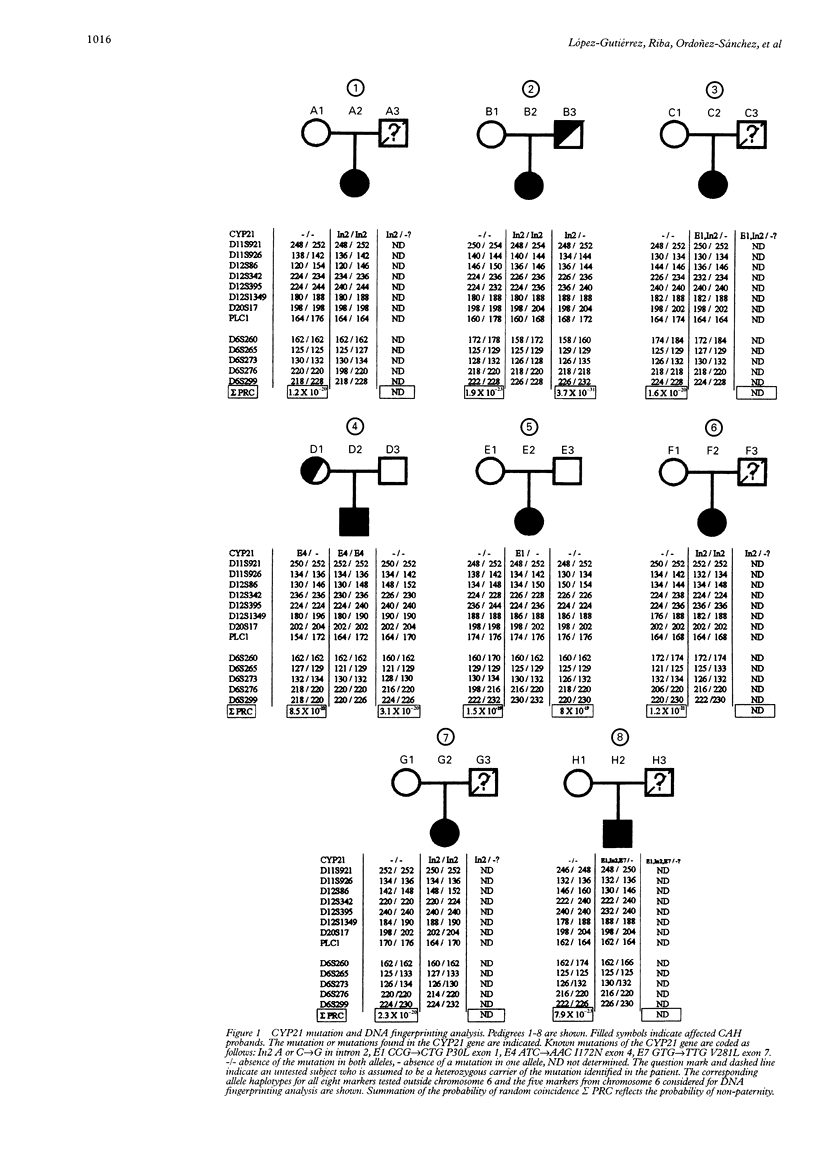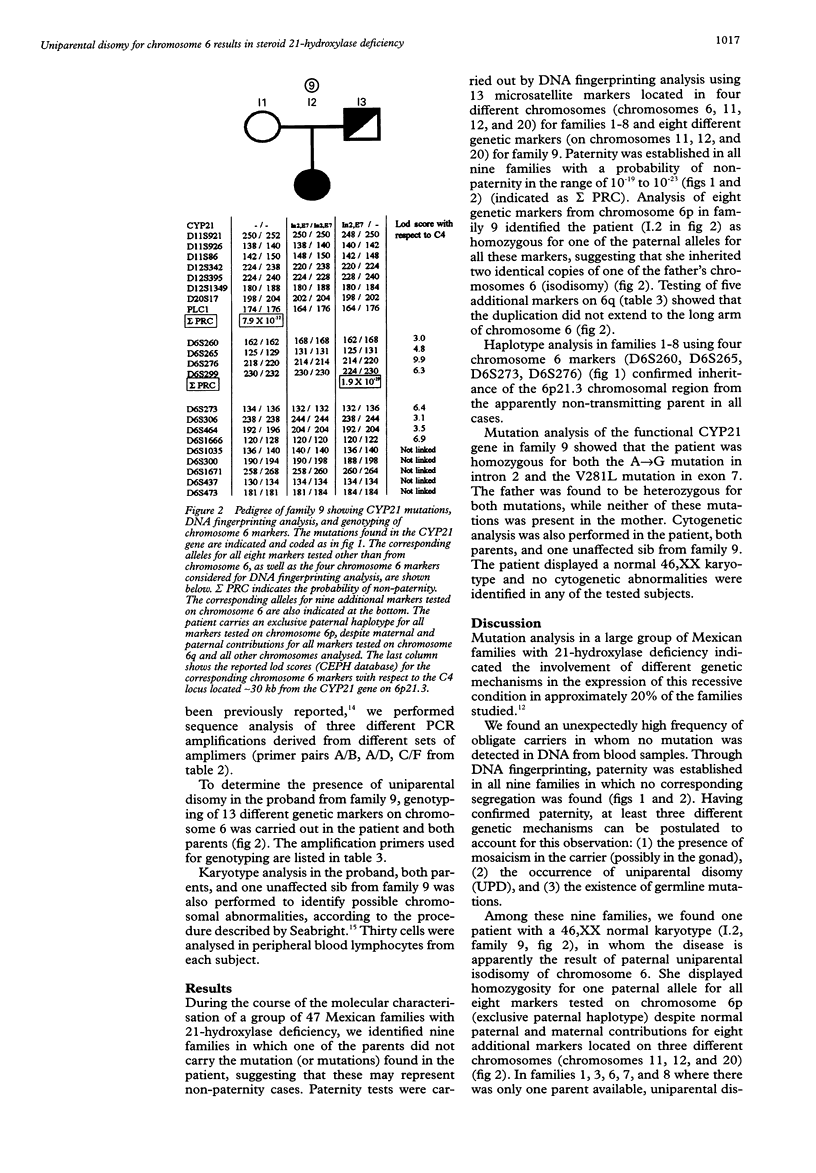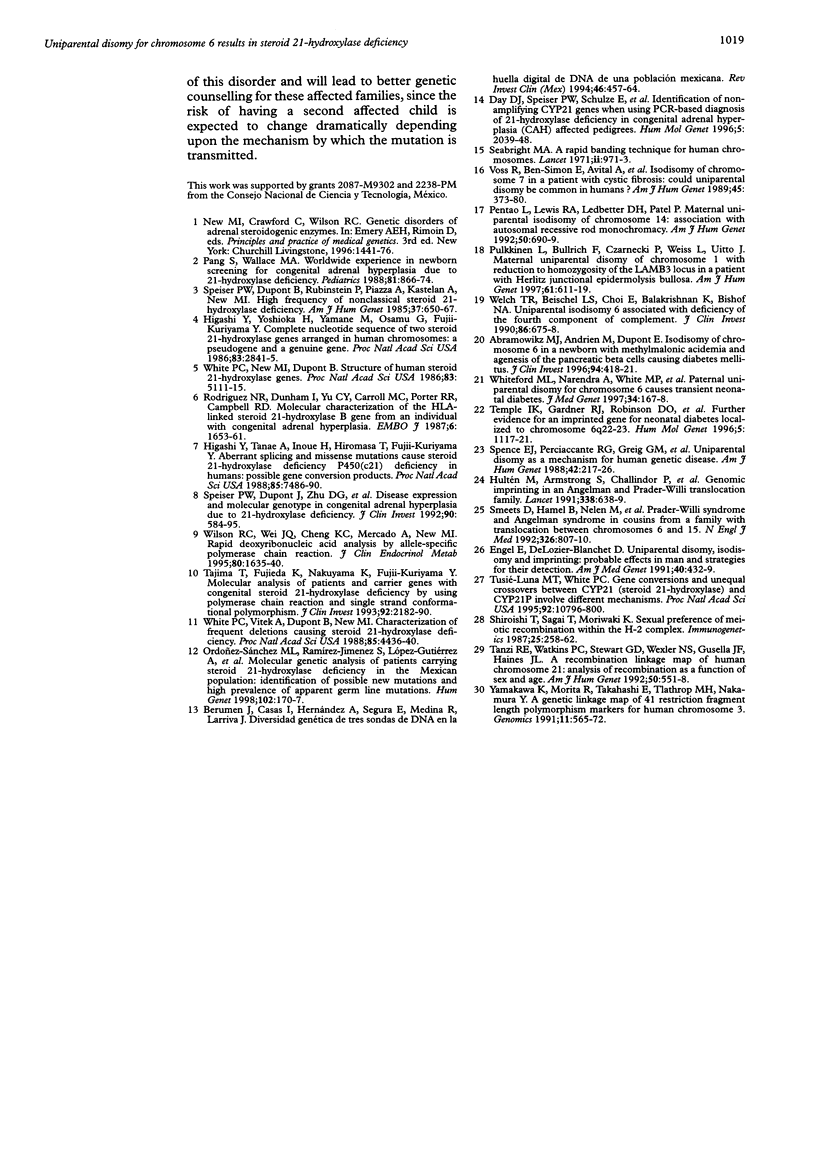Abstract
Congenital adrenal hyperplasia (CAH) is an inherited recessive disorder of adrenal steroidogenesis caused by mutations in the steroid 21-hydroxylase gene (CYP21) in more than 90% of affected patients. The CYP21 gene is located within the HLA complex locus on chromosome 6 (6p21.3). During a molecular characterisation study of a group of 47 Mexican families with 21-hydroxylase deficiency, we identified nine in which the mutation or mutations found in the patient did not appear to originate from one of the parents. Through DNA fingerprinting, paternity was established in all nine families with a probability of non-paternity in the range of 10(-19) to 10(-23). Among these families, we identified one patient with exclusive paternal inheritance of all eight markers tested on chromosome 6p, despite normal maternal and paternal contributions for eight additional markers on three different chromosomes. We did not identify duplication of paternal information for markers in the 6q region, consistent with lack of expression of transient neonatal diabetes owing to genomic imprinting in this patient. Our results substantiate evidence for the existence of different genetic mechanisms involved in the expression of this recessive condition in a substantial portion (approximately 19%) of affected Mexican families. In addition to the identification of a patient with paternal uniparental disomy, the occurrence of germline mutations may explain the unusual pattern of segregation in the majority of the remaining eight families.
Full text
PDF





Selected References
These references are in PubMed. This may not be the complete list of references from this article.
- Berumen-Campos J., Casas-Avila L., Hernández-Mendoza A., Segura-Salinas E., Medina-León R., Larriva-Sahd J. Diversidad genética de tres sondas de DNA en la huella digital de DNA de una población mexicana. Rev Invest Clin. 1994 Nov-Dec;46(6):457–464. [PubMed] [Google Scholar]
- Day D. J., Speiser P. W., Schulze E., Bettendorf M., Fitness J., Barany F., White P. C. Identification of non-amplifying CYP21 genes when using PCR-based diagnosis of 21-hydroxylase deficiency in congenital adrenal hyperplasia (CAH) affected pedigrees. Hum Mol Genet. 1996 Dec;5(12):2039–2048. doi: 10.1093/hmg/5.12.2039. [DOI] [PubMed] [Google Scholar]
- Engel E., DeLozier-Blanchet C. D. Uniparental disomy, isodisomy, and imprinting: probable effects in man and strategies for their detection. Am J Med Genet. 1991 Sep 15;40(4):432–439. doi: 10.1002/ajmg.1320400411. [DOI] [PubMed] [Google Scholar]
- Higashi Y., Tanae A., Inoue H., Hiromasa T., Fujii-Kuriyama Y. Aberrant splicing and missense mutations cause steroid 21-hydroxylase [P-450(C21)] deficiency in humans: possible gene conversion products. Proc Natl Acad Sci U S A. 1988 Oct;85(20):7486–7490. doi: 10.1073/pnas.85.20.7486. [DOI] [PMC free article] [PubMed] [Google Scholar]
- Higashi Y., Yoshioka H., Yamane M., Gotoh O., Fujii-Kuriyama Y. Complete nucleotide sequence of two steroid 21-hydroxylase genes tandemly arranged in human chromosome: a pseudogene and a genuine gene. Proc Natl Acad Sci U S A. 1986 May;83(9):2841–2845. doi: 10.1073/pnas.83.9.2841. [DOI] [PMC free article] [PubMed] [Google Scholar]
- Hultén M., Armstrong S., Challinor P., Gould C., Hardy G., Leedham P., Lee T., McKeown C. Genomic imprinting in an Angelman and Prader-Willi translocation family. Lancet. 1991 Sep 7;338(8767):638–639. doi: 10.1016/0140-6736(91)90652-6. [DOI] [PubMed] [Google Scholar]
- Ordoñez-Sánchez M. L., Ramírez-Jiménez S., López-Gutierrez A. U., Riba L., Gamboa-Cardiel S., Cerrillo-Hinojosa M., Altamirano-Bustamante N., Calzada-León R., Robles-Valdés C., Mendoza-Morfin F. Molecular genetic analysis of patients carrying steroid 21-hydroxylase deficiency in the Mexican population: identification of possible new mutations and high prevalence of apparent germ-line mutations. Hum Genet. 1998 Feb;102(2):170–177. doi: 10.1007/s004390050672. [DOI] [PubMed] [Google Scholar]
- Pang S. Y., Wallace M. A., Hofman L., Thuline H. C., Dorche C., Lyon I. C., Dobbins R. H., Kling S., Fujieda K., Suwa S. Worldwide experience in newborn screening for classical congenital adrenal hyperplasia due to 21-hydroxylase deficiency. Pediatrics. 1988 Jun;81(6):866–874. [PubMed] [Google Scholar]
- Pentao L., Lewis R. A., Ledbetter D. H., Patel P. I., Lupski J. R. Maternal uniparental isodisomy of chromosome 14: association with autosomal recessive rod monochromacy. Am J Hum Genet. 1992 Apr;50(4):690–699. [PMC free article] [PubMed] [Google Scholar]
- Pulkkinen L., Bullrich F., Czarnecki P., Weiss L., Uitto J. Maternal uniparental disomy of chromosome 1 with reduction to homozygosity of the LAMB3 locus in a patient with Herlitz junctional epidermolysis bullosa. Am J Hum Genet. 1997 Sep;61(3):611–619. doi: 10.1086/515524. [DOI] [PMC free article] [PubMed] [Google Scholar]
- Rodrigues N. R., Dunham I., Yu C. Y., Carroll M. C., Porter R. R., Campbell R. D. Molecular characterization of the HLA-linked steroid 21-hydroxylase B gene from an individual with congenital adrenal hyperplasia. EMBO J. 1987 Jun;6(6):1653–1661. doi: 10.1002/j.1460-2075.1987.tb02414.x. [DOI] [PMC free article] [PubMed] [Google Scholar]
- Seabright M. A rapid banding technique for human chromosomes. Lancet. 1971 Oct 30;2(7731):971–972. doi: 10.1016/s0140-6736(71)90287-x. [DOI] [PubMed] [Google Scholar]
- Shiroishi T., Sagai T., Moriwaki K. Sexual preference of meiotic recombination within the H-2 complex. Immunogenetics. 1987;25(4):258–262. doi: 10.1007/BF00404696. [DOI] [PubMed] [Google Scholar]
- Smeets D. F., Hamel B. C., Nelen M. R., Smeets H. J., Bollen J. H., Smits A. P., Ropers H. H., van Oost B. A. Prader-Willi syndrome and Angelman syndrome in cousins from a family with a translocation between chromosomes 6 and 15. N Engl J Med. 1992 Mar 19;326(12):807–811. doi: 10.1056/NEJM199203193261206. [DOI] [PubMed] [Google Scholar]
- Speiser P. W., Dupont B., Rubinstein P., Piazza A., Kastelan A., New M. I. High frequency of nonclassical steroid 21-hydroxylase deficiency. Am J Hum Genet. 1985 Jul;37(4):650–667. [PMC free article] [PubMed] [Google Scholar]
- Speiser P. W., Dupont J., Zhu D., Serrat J., Buegeleisen M., Tusie-Luna M. T., Lesser M., New M. I., White P. C. Disease expression and molecular genotype in congenital adrenal hyperplasia due to 21-hydroxylase deficiency. J Clin Invest. 1992 Aug;90(2):584–595. doi: 10.1172/JCI115897. [DOI] [PMC free article] [PubMed] [Google Scholar]
- Spence J. E., Perciaccante R. G., Greig G. M., Willard H. F., Ledbetter D. H., Hejtmancik J. F., Pollack M. S., O'Brien W. E., Beaudet A. L. Uniparental disomy as a mechanism for human genetic disease. Am J Hum Genet. 1988 Feb;42(2):217–226. [PMC free article] [PubMed] [Google Scholar]
- Tajima T., Fujieda K., Nakayama K., Fujii-Kuriyama Y. Molecular analysis of patient and carrier genes with congenital steroid 21-hydroxylase deficiency by using polymerase chain reaction and single strand conformation polymorphism. J Clin Invest. 1993 Nov;92(5):2182–2190. doi: 10.1172/JCI116820. [DOI] [PMC free article] [PubMed] [Google Scholar]
- Tanzi R. E., Watkins P. C., Stewart G. D., Wexler N. S., Gusella J. F., Haines J. L. A genetic linkage map of human chromosome 21: analysis of recombination as a function of sex and age. Am J Hum Genet. 1992 Mar;50(3):551–558. [PMC free article] [PubMed] [Google Scholar]
- Temple I. K., Gardner R. J., Robinson D. O., Kibirige M. S., Ferguson A. W., Baum J. D., Barber J. C., James R. S., Shield J. P. Further evidence for an imprinted gene for neonatal diabetes localised to chromosome 6q22-q23. Hum Mol Genet. 1996 Aug;5(8):1117–1121. doi: 10.1093/hmg/5.8.1117. [DOI] [PubMed] [Google Scholar]
- Tusié-Luna M. T., White P. C. Gene conversions and unequal crossovers between CYP21 (steroid 21-hydroxylase gene) and CYP21P involve different mechanisms. Proc Natl Acad Sci U S A. 1995 Nov 7;92(23):10796–10800. doi: 10.1073/pnas.92.23.10796. [DOI] [PMC free article] [PubMed] [Google Scholar]
- Voss R., Ben-Simon E., Avital A., Godfrey S., Zlotogora J., Dagan J., Tikochinski Y., Hillel J. Isodisomy of chromosome 7 in a patient with cystic fibrosis: could uniparental disomy be common in humans? Am J Hum Genet. 1989 Sep;45(3):373–380. [PMC free article] [PubMed] [Google Scholar]
- Welch T. R., Beischel L. S., Choi E., Balakrishnan K., Bishof N. A. Uniparental isodisomy 6 associated with deficiency of the fourth component of complement. J Clin Invest. 1990 Aug;86(2):675–678. doi: 10.1172/JCI114760. [DOI] [PMC free article] [PubMed] [Google Scholar]
- White P. C., New M. I., Dupont B. Structure of human steroid 21-hydroxylase genes. Proc Natl Acad Sci U S A. 1986 Jul;83(14):5111–5115. doi: 10.1073/pnas.83.14.5111. [DOI] [PMC free article] [PubMed] [Google Scholar]
- White P. C., Vitek A., Dupont B., New M. I. Characterization of frequent deletions causing steroid 21-hydroxylase deficiency. Proc Natl Acad Sci U S A. 1988 Jun;85(12):4436–4440. doi: 10.1073/pnas.85.12.4436. [DOI] [PMC free article] [PubMed] [Google Scholar]
- Whiteford M. L., Narendra A., White M. P., Cooke A., Wilkinson A. G., Robertson K. J., Tolmie J. L. Paternal uniparental disomy for chromosome 6 causes transient neonatal diabetes. J Med Genet. 1997 Feb;34(2):167–168. doi: 10.1136/jmg.34.2.167. [DOI] [PMC free article] [PubMed] [Google Scholar]
- Wilson R. C., Wei J. Q., Cheng K. C., Mercado A. B., New M. I. Rapid deoxyribonucleic acid analysis by allele-specific polymerase chain reaction for detection of mutations in the steroid 21-hydroxylase gene. J Clin Endocrinol Metab. 1995 May;80(5):1635–1640. doi: 10.1210/jcem.80.5.7745011. [DOI] [PubMed] [Google Scholar]
- Yamakawa K., Morita R., Takahashi E., Hori T., Lathrop M., Nakamura Y. A genetic linkage map of 41 restriction fragment length polymorphism markers for human chromosome 3. Genomics. 1991 Nov;11(3):565–572. doi: 10.1016/0888-7543(91)90063-k. [DOI] [PubMed] [Google Scholar]


